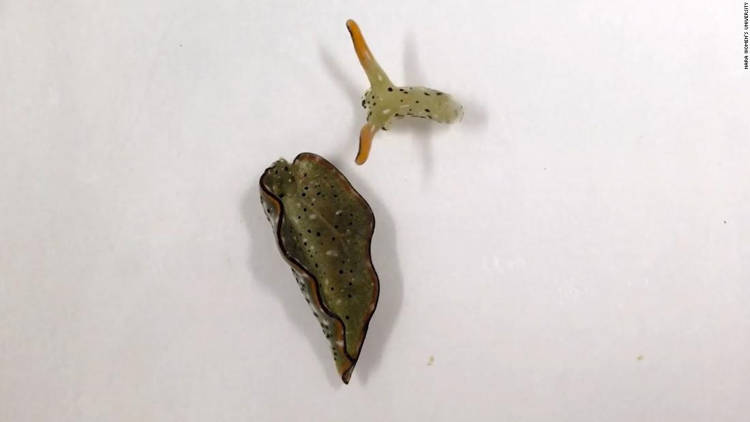Japanese researchers recently the incredible ability of a sea slug to basically sever its own head and simply grow a new body, complete with fresh vital organs.
Autotomy, the behavior whereby an animal sheds or discards one or more of its own appendages, usually as self-defense mechanism, only to grow them back later, is well documented in the animal world. However, autotomy usually involves limbs or tails, appendages that don’t feature vital organs, whish is why a sea slug that can apparently sever its own head and then grow a new body complete with these vital organs has stunned scientists.

Photo: Sayaka Mitoh/Yoichi Yusa
Researchers at the Nara Women’s University in Japan were observing sea slug specimens of the genus Elysia, when they observed something peculiar. One of the slugs appeared to shed its whole body, continuing to live on as just the head. Scientists figured that it would die shortly after, but within hours the slug started feeding on algae again. In a few days, the wound where the head was severed was healed, and within three weeks, it had developed a new body, complete with vital organs.
“We were really surprised to see the head moving just after autotomy,” PhD student Sayaka Mitoh and ecologist Yoichi Yusa wrote in a study published this week. “We thought that it would die soon without a heart and other important organs, but we were surprised again to find that it started to regenerate the body.”
“This is the first example of such extreme autotomy as far as we know,” the two co-authors added. “Some other animals such as planarians, starfish, and polychaetes have greater abilities of regeneration, but most of them do not have a heart (in polychaetes, blood vessels with muscular pumps are sometimes called the heart).”
Interestingly, while researchers reported this remarkable type of autotomy in nine specimens, they concluded that only young specimens were capable of growing back their bodies. Older sea slugs that had hatched 480 to 520 days before severing their heads, could not survive the decapitation. They were unable to feed and died within 10 days.
Weirdly enough, the discarded bodies of the slugs didn’t grow back their heads, but responded to tactile stimuli for up to 10 months after the autotomy. Researchers reported that the beating of the heart was visible just before the body decomposed.
Scientists can’t really explain how the sea slugs survive without vital organs until they grow new ones, but one possible explanation is that they can use chloroplasts from the algae they eat to sustain themselves through photosynthesis, until their body completely regenerates. That is just a theory though, one that still needs to be proven true.
As for the purpose of this bizarre yet remarkable self-amputation, researchers believe that it is an evolutionary mechanism that enables sea slugs to free themselves of parasites. All of the sea slugs that severed their heads during this study were infected with some sort of parasite, which they successfully got rid of after discarding their bodies. In contrast, none of the parasite-free even attempted this form of autotomy.
“We think this autotomy requires a great cost (losing 80% of the total weight) and the older ones simply cannot stand the burden,” the study authors wrote. “Then the autotomy may appear a ‘silly’ choice, but the old ones will die soon anyway and there may be a chance of surviving and regenerating a parasite-free body.”
Mitoh and Yusa will continue to study this new and intriguing form of autotomy at both the tissue and cellular levels, and also investigate if this phenomenon occurs in other species of sacoglossans.












